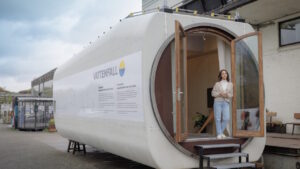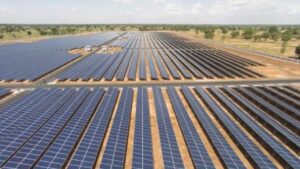Australia’s leading solar research scientists have achieved another significant milestone, reporting a huge leap in solar cell efficiency that could in time lead to a quantum reduction in solar power costs.
A University of NSW team led by the renowned Professor Martin Green and Dr Mark Keevers (pictured above) has reported a new world efficiency record for solar cells using unfocussed sunlight, the sort of light that falls on the rooftop solar modules on homes and businesses.
The striking part of the new record is that it is so far ahead of previous achievements – 34.5 per cent instead of 24 per cent – and is edging closer to the theoretical limits of sunlight to electricity conversion – and more than three decades before recent predictions.
It also sets the scene for another step change in the cost of solar – which is already falling below US3c/kWh in recent contracts (in the Middle East), and is set to become unbeatable in terms of levellised cost of energy across all energy sources. Future modules will be smaller, more powerful, and will provide cheaper power.
However, the scientists also voiced their concern about the future of solar R&D in Australia, given that much of it is made possible by funding from the Australian Renewable Energy Agency, which the Coalition wants to effectively close in all but name, end grant payments and strip $1.3 billion in legislated funding.
“We must maintain the pace of photovoltaic research in Australia to ensure that we not only build on such tremendous results, but continue to bring benefits back to Australia,” Green said in the statement.
The Coalition government is justifying its decision on the basis that it wants to ensure that taxpayers “get their money back”. ARENA spent $1.4 million on the UNSW research.
But Green released a new study that showed research in solar PV had already generated flow-on benefits of more than $8 billion to Australia, and gains in efficiency alone, made possible by UNSW’s PERC cells, are forecast to save $750 million in domestic electricity generation in the next decade.
“If you want to have R&D in solar technologies, you have to invest in it, you have to fund it,” Keevers told RenewEconomy.
ARENA CEO Ivor Frischknecht said the achievement demonstrated the importance of supporting early stage renewable energy technologies.
“Australia already punches above its weight in solar R&D and is recognised as a world leader in solar innovation,” Mr Frischknecht said.
“These early stage foundations are increasingly making it possible for Australia to return solar dividends here at home and in export markets – and there’s no reason to believe the same results can’t be achieved with this record-breaking technology.
“With the right support, Australia’s world leading R&D is well placed to translate into efficiency wins for households through the ongoing roll out of rooftop solar and utility-scale solar projects such as those being advanced by ARENA through its current $100 million large-scale solar round.
Keevers and Green set the record at UNSW’s Australian Centre for Advanced Photovoltaics using a 28cm2 four-junction mini-module – embedded in a prism – that extracts the maximum energy from sunlight.
It does this by splitting the incoming rays into four bands, using a hybrid four-junction receiver to squeeze even more electricity from each beam of sunlight.
The UNSW result, confirmed by the US National Renewable Energy Laboratory, is almost 44 per cent better than the previous record – made by Alta Devices of the USA, which reached 24 per cent efficiency but over a larger surface area of 800cm2.
“This encouraging result shows that there are still advances to come in photovoltaics research to make solar cells even more efficient,” Keevers said in a statement.
“Extracting more energy from every beam of sunlight is critical to reducing the cost of electricity generated by solar cells as it lowers the investment needed, and delivering payback faster.”
The same UNSW team set a world record in 2014 of more than 40 per cent efficiency, but this was achieved by using mirrors to concentrate the light – a technique known as CPV (concentrator photovoltaics) – and then similarly splitting out various wavelengths.
The new result, however, was achieved using normal sunlight with no concentrators, and Green said that this level of efficiency was not expected to be achieved for many years.
Indeed, a recent study by Germany’s Agora Energiewende think tank set an aggressive target of 35 per cent efficiency by 2050 for a module that uses unconcentrated sunlight, such as the standard ones on family homes.
That efficiency target – double the efficiency of most modules in use now – is the basis for predictions that solar will fall to 2c/kWh, or even lower.
“Things are moving faster in solar cell efficiency than many experts expected, and that’s good news for solar energy,” Green said in the statement.
Keevers added in a phone interview, however, that it is early days, and these solar cells will not find their way into rooftop modules anytime soon.
They are still complex and expensive, but manufacturing processes should bring that cost down quickly. At least initially, they are more likely to be used in solar tower technology, of the type being developed by Australia’s RayGen.
More from UNSW on the technology details of their breakthrough:
“The record-setting UNSW mini-module combines a silicon cell on one face of a glass prism, with a triple-junction solar cell on the other.
“The triple-junction cell targets discrete bands of the incoming sunlight, using a combination of three layers: indium-gallium-phosphide; indium-gallium-arsenide; and germanium.
“As sunlight passes through each layer, energy is extracted by each junction at its most efficient wavelength, while the unused part of the light passes through to the next layer, and so on.
“Some of the infrared band of incoming sunlight, unused by the triple-junction cell, is filtered out and bounced onto the silicon cell, thereby extracting just about all of the energy from each beam of sunlight hitting the mini-module.
“The 34.5% result with the 28 cm2 mini-module is already a world record, but scaling it up to a larger 800-cm2 – thereby leaping beyond Alta Devices’ 24% – is well within reach.
“There’ll be some marginal loss from interconnection in the scale-up, but we are so far ahead that it’s entirely feasible,” Keevers said. The theoretical limit for such a four-junction device is thought to be 53%, which puts the UNSW result two-thirds of the way there.
“Multi-junction solar cells of this type are unlikely to find their way onto the rooftops of homes and offices soon, as they require more effort to manufacture and therefore cost more than standard crystalline silicon cells with a single junction. But the UNSW team is working on new techniques to reduce the manufacturing complexity, and create cheaper multi-junction cells.
“However, the spectrum-splitting approach is perfect for solar towers, like those being developed by Australia’s RayGen, which use mirrors to concentrate sunlight which is then converted directly into electricity.
“The research was funded by ARENA and by UNSW, in partnership with RayGen, an Australian developer of PV power tower technology; Trina Solar, a PV module manufacturer; and the US National Renewable Energy Laboratory.










